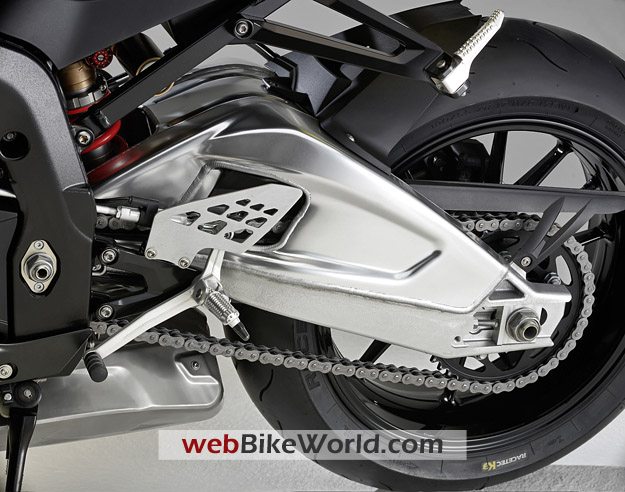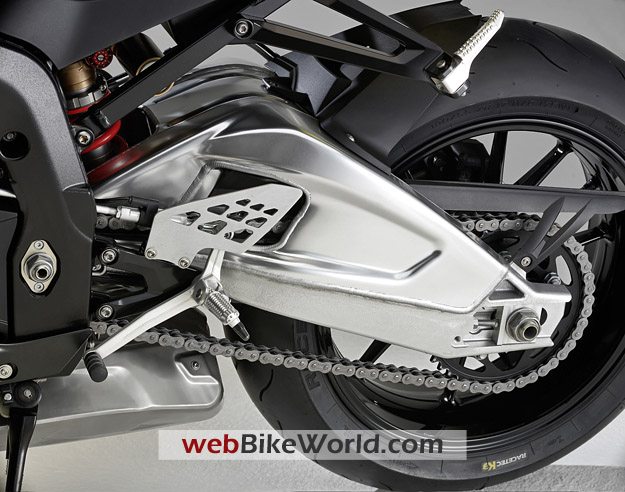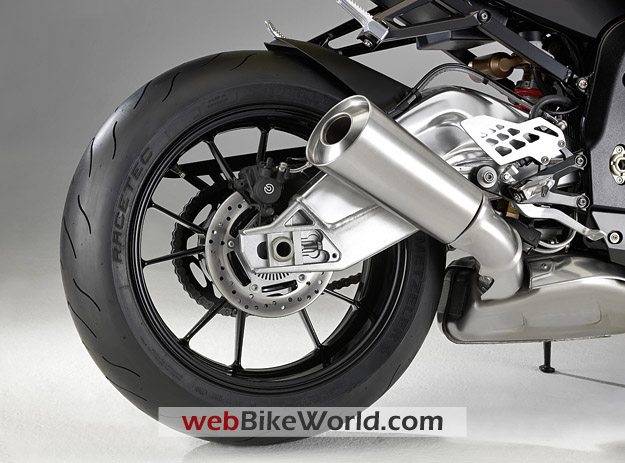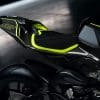BMW S 1000 RR SuperSports Street Motorcycle – Part 3: Suspension
BMW S1000RR SuperSports Street Bike Report:
- Part 1 Overall Concept and Features
- Part 2 Drivetrain
- Part 3 Suspension and Running Gear
- Part 4 Page 4 Includes:
BMW S1000RR Part 3: Suspension and Running Gear
In conjunction with optimum ergonomics, the slender structure of the motorcycle also helps to provide a particularly good and safe riding experience as well as very smooth and easy handling.
Aluminum bridge frame with the engine serving as a load-bearing element.
The result of this development process is an aluminum bridge frame made up of four castings. This particularly configuration serves above all to meet the great challenges in designing a motorcycle with a very slim waist and a large airbox.
The spread of stiffness values follows a wide range of calculations and simulations as well as many riding tests taking all kinds of variants into account. The steering head and the two side sections with their integrated engine mounts are manufactured in a tip casting process.
The rear section with the rear engine mount, the swing arm supports as well as the mounting points for the footrests and kinematic elements are made in a low-pressure die-casting process.
A high-precision welding robot then assembles the individual components in the Aluminum Competence Centre at BMW Motorrad’s Berlin Plant to form an extra-stiff and sturdy unit all round.
The rear frame section on the S 1000 RR is a welded structure made up of square aluminum profiles bolted on to the frame. Again, this combines low weight with superior stability and robust strength appreciated particularly by competition riders and teams on the race track.
A further advantage of this configuration is that it allows optimum access to the spring strut, for example when changing the set-up for specific requirements.
Longer Swingarm for Optimum Traction
Consistently seeking to give the S 1000 RR optimum performance in every respect, the development team at BMW Motorrad, in developing the suspension and running gear, concentrated in particular on the mechanical grip of the wheels and, accordingly, on the overall need for supreme traction.
These requirements are fulfilled above all by the long rear-wheel swing arm helping to reduce lift-up and wheel relief forces on the rear wheel thanks to the drive and thrust forces conveyed by the upper and lower chain element. In practice this means optimum transmission of drive power, superior performance and a smooth and reliable response at the rear particularly while accelerating, with substantial advantages for the rider.
With its effective overall length between the swing arm rotation point and the rear wheel axle of 593 millimeters or 23.35″, the S 1000 RR comes with one of the longest swing arms in the supersports segment.
The swing arm mount in the frame also helps to promote supersports performance, particularly on the race track, with the inserts for the swing arm mounts in the frame serving to vary the height of the swingarm rotation point and, accordingly, the anti-squat effect when accelerating, thus meeting the rider’s personal requirements and the particular requirements of a specific race track or stretch of road.
For reasons of weight and to ensure maximum torsional stiffness, the configuration chosen is a double swing arm made of deep-drawn aluminum plates with particularly thin walls as well as a cast dish at the bottom. This cast dish houses all components subject to high mechanical loads such as the kinematic pivot and junction points, the swing arm mount, and the rear wheel support.
A further advantage of the cast dish at the bottom is the reduction of tolerances in production to an absolute minimum on all of these kinematically relevant points. Together with the cast dish, three separate components made of deep-drawn aluminum plates with wall thickness of just 2.5 millimeters or 0.098″ form a torsionally stiff and very light swing arm body weighing just 6.22 kg or 13.72 lb.
On the left-hand side the drive chain runs through the swing arm in a shaft. The wide range of adjustment on the rear axle support of 45 millimeters or 1.77″ provides the option to change the position of the rear axle, moving forward by up to 17.5 millimeters or 0.69″ and backward by up to 27.5 millimeters or 1.08″, depending on whether the rider is looking for a reduced wheelie effect (adjustment to the rear) or more traction (adjustment to the front).
Wheelbase thus varies from 1,414.5 millimeters or 55.69″ to 1.459.5 millimeters or 57.46″, with the standard wheelbase under DIN unladen weight measuring 1.432 millimeters or 56.38″.
Fully Adjustable Suspension Elements With Very High Damping Rates
Seeking to give the new S 1000 RR optimum suspension qualities with perfect running gear, the engineers and specialists at BMW Motorrad decided to give the new machine a central spring strut with an adjustable spring base as well as adjustable damper inbound and rebound control.
A further advantage is that this configuration allows the adjustment of low-speed damping (for example on long, stretched-out undulating surfaces) and high-speed damping (e.g., on short bumps) on the pressure stage (inbound), thus offering perfect set-up qualities with maximum precision.
The spring strut is activated by compact and light kinematic levers and makes allowance for the wide range of use also on the race track by offering a wide range of adjustment as well as very substantial damping reserves. Overall spring travel on the rear wheel axle is 130 millimeters or 5.12″, with 90 millimeters or 3.54″ positive and 40 millimeters or 1.57″ negative spring travel.
Using eccentric inserts on the upper spring strut support, the rider is able to raise the entire rear end of the S 1000 RR by 10 millimeters or 0.39″ on the spring strut support, thus taking his individual requirements and the specific character of the respective route into account.
The S 1000 RR meets equally high demands in terms of riding dynamics also on the front suspension. The configuration used up front is an upside-down fork with its fi xed tube measuring an ample 46 millimeters or 1.81″ in diameter.
This size alone is quite unique in the supersports segment, offering far greater braking stability and better feedback than the usual fixed tubes measuring 43 millimeters or 1.69″ in diameter. The fixed tube is mounted on the steering head by a light aluminum steering shaft tube running in two extra-large ball bearings as well as two fork bridges made of forged aluminum in the interest of minimum weight.
To adjust the height of the motorcycle at the front to the personal needs and preferences of the rider as well as the route he is taking, the immersion tube at the front provides an appropriate overlap, overall adjustment travel of 15 millimeters or 0.59″ allowing the front end to be lowered by up to 5 millimeters or 0.197″ and raised by up to 10 millimeters or 0.394″.
The upside-down fork comes with cartridge inserts inside, that is a separate hydraulic piston cylinder system, and allows adjustment of both the spring base as well as damper rebound and inbound action. Here again, the sensitive behavior and response of the suspension, the wide range of adjustment and very significant damping reserves even on the race track offer superior flexibility and individual choice.
Overall spring travel is 120 millimeters or 4.72″, with 75 millimeters or 2.95″ positive and 45 millimeters or 1.77″ negative spring travel. To allow simple and reliable control at all times, the individual settings on both the spring strut and the upside-down fork are clearly specified by numbers ranging from 1 to 10. So there is no need to count up to 30 clicks in the usual tedious process required on some other models in this segment.
A further advantage is that both the inbound and rebound stages are color marked, again – like many other features – confirming the very practical approach taken by the development engineers at BMW Motorrad.
Very Light and Extra-Stiff Aluminum Wheels.
Designed and configured from the outset as a supersports machine offering supreme performance, the new S 1000 RR obviously also comes with appropriate wheels. These are filigree ten-spoke pressure-cast aluminum wheels in truly dynamic design offering optimum qualities in every respect.
Once again, one of the primary objectives in developing the wheels was to reduce weight to an absolute minimum while retaining a supreme standard of all-round strength and stability. Precisely this is why the brake discs do not come with a separate mount and the additional bolts which would be required for this purpose – instead, the brake disc rings are fitted directly around the wheel hubs.
This alone and the particular construction of the wheels makes the wheels on the S 1000 RR the lightest in their segment. On the front wheel the brake discs are connected directly to an extra-strong wheel star, without any additional mounting or attachment elements.
The five radial arms of the star extending out of the hub form individual forks supporting the rim consistently by means of ten cast spokes. This fork configuration gives the front wheel excellent radial stability in shape also under high wheel loads and at the same time caters for the significant circumferential forces acting on the wheel above all when applying the brakes.
This design of the wheel tailored to load conditions and requirements helps to keep the spokes very filigree and light, not only reducing the weight of the wheel, but also providing a very light and transparent look. Drive and thrust forces are transmitted on the rear chain by means of an integrated thrust damper.
Tire dimensions of 120/70 ZR 17 at the front and, respectively, 190/55 ZR 17 at the rear represent the latest state of the art in the supersports segment.
Radial Brakes for Excellent Stopping Power
The brake system on the new S 1000 RR lives up to the high standard of performance on the drivetrain and suspension in every respect. Here again, therefore, the development specialists at BMW Motorrad have given utmost
attention to meeting all the demands and wishes of the most discerning supersports customers.
To fulfill these requirements, the front wheel comes with a double disc brake incorporating two steel brake discs in floating arrangement and measuring 320 millimeters or 12.60″ in diameter and 5 millimeters or 0.197″ across.
The hydraulic system incorporates a radial master cylinder with its master piston measuring 19.05 millimeters or 0.75″ in diameter as well as two radially-mounted four-piston fixed-caliper brakes from Brembo with brake pistons 34 millimeters or 1.34″ in diameter and split friction pads made of sintered metal.
Brake lines in steel tissue cladding and therefore very strong and stable serve to convey the brake forces exerted by the rider with his hand in an optimum, smooth and absolutely reliable process. The entire brake system on the S 1000 RR stands out, as a result, through its crystal-clear pressure point, optimum brake efficiency and clear dosage of brake power with maximum resistance to fading and high temperatures not only on the road, but also and in particular on the track.
The rear wheel comes with a hydraulically operated single-disc brake supporting the brake at the front. Diameter of the steel brake disc fitted firmly in position is 220 millimeters or 8.66″, disc thickness is 5 millimeters or 0.197″.
The rear wheel brake is operated by the footbrake lever acting on the 12.7-millimetre (0.50″) master piston in the main brake cylinder and from there, via the pressure-stable, steel-clad brake line, on an extra-light single-piston floating caliper likewise featuring sintered metal pads.
Race ABS With Four Pressure Sensors
BMW Motorrad Race ABS specifically developed for supersports requirements and available as an option straight from the factory ensures maximum active safety when braking, again making allowance for the outstanding performance and unique character of the S 1000 RR.
To comply with various riding conditions such as a wet surface (“Rain”), regular road conditions (“Sport”), a race track with supersports tires (“Race”) or a race track with slicks (“Slick”), the rider is able to adjust the characteristic features and performance of the engine simply by pressing a button, thus giving Race ABS the right configuration and input at all times.
These characteristics interact with the respective riding modes and are carefully coordinated with one another for maximum safety at all times.
This new BMW Motorrad Race ABS is a brand-new development from the ground up, once again significantly lighter than all former partly integrated systems. With the control unit weighing just 1.65 kg or 3.64 lb and with overall weight of just 2.5 kg or 5.51 lb, BMW Motorrad Race ABS offers excellent qualities specifically for a supersports machine.
And apart from its low weight, the system stands out in particular through its further improved control and operating functions. Over and above the excellent overall set-up, this superior control, performance and brake management is ensured by the use of four pressure sensors which, in conjunction with the very elaborate rear-wheel lift-off detector, allows even better distinction than before between a bump on the road and the rear wheel locking.
Pulling the handbrake lever, the rider activates the double-disc brake at the front, while brake pressure on the rear-wheel brake remains at a low level. Pressing the footbrake lever, the rider then activates the rear-wheel brake as well. In the Race and Slick Modes, the rear-wheel lift-off detector does not intervene in the rider’s braking action, allowing him to apply the brakes even harder whenever required, for example on slightly undulating surfaces and where the motorcycle has adequate grip.
In the Slick Mode the rider still has ABS on both wheels when pulling the handbrake lever alone. Then, pressing down the foot brake, the particularly experienced rider is able to go into a brake drift without having to forego the benefits of front-wheel ABS. In other words, ABS no longer cuts in on the rear wheel when pressing down the footbrake lever.
As soon as the rider pulls the handbrake lever, the pressure sensor integrated in the front-wheel control circuit switches on the brake light and the pump, the latter immediately delivering brake fluid through the open valve to the rear wheel circuit.
The pressure set in the rear wheel circuit is measured by a second pressure sensor and is controlled according to the distribution of brake power required and the brake force generated by the rider. The third pressure sensor in the rear control circuit, finally, measures the brake pressure activated by the rider‘s foot.
Use of a fourth pressure sensor in the front wheel circuit allows further improvement and even finer control of front-wheel brake pressure compared with former BMW Integral ABS II, since the system is able to compare the actual level of pressure in the control and wheel circuits.
As a result, there is now no need for the usual throttle blades, which serves to provide an optimum pressure point and allows perfect dosage of brake power. All pressure sensors are integrated in the pressure modulator and the overall configuration of the system with its integrated pressure sensors now also avoids the need for a brake light switch.
Yet a further option is to deactivate Race ABS completely for special purposes and requirements. While Race ABS gives the rider valuable support and therefore represents a very significant safety factor when applying the brakes, it is not able to re-define or change the laws and limits to riding physics.
Hence, even with this most sophisticated system, the rider may still misjudge a situation or make a mistake on his machine leading, should the worst come to the worst, to an accident. Race ABS nevertheless helps the driver use the supreme stopping power and brake qualities of the S 1000 RR much better and more safely.
But even Race ABS cannot provide maximum stopping power at the physical friction limit when leaning over to the side, and does not relieve the rider of his responsibility to ride safely and carefully.
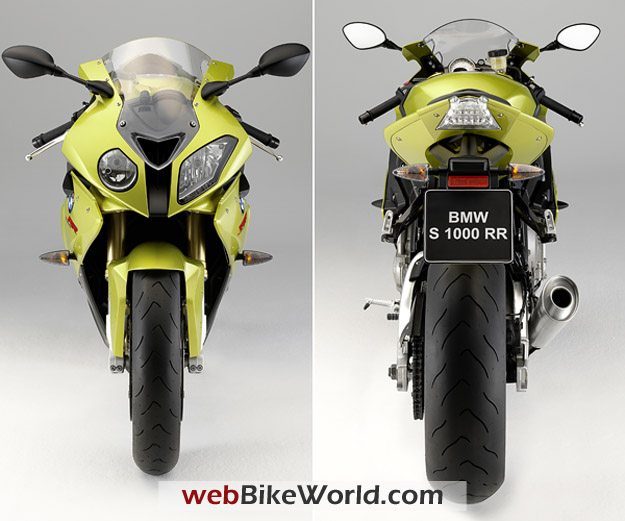

Weight-Optimized Hybrid On-Board Network
Contrary to most models from BMW Motorrad, the S 1000 RR does not come with central vehicle electronics (CVE) in the conventional sense, but rather features a hybrid on-board network where, thanks to the smaller range of equipment – for example no heated handles or no 12V power socket – there is no need for a central control unit.
Instead, the functions of CVE are integrated in the instrument cluster and there is a relay box at the rear of the motorcycle. The S 1000 RR nevertheless uses a CAN (Controller Area Network) bus system to control and mastermind various functions of the motorcycle, networking the instrument cluster, the ABS and engine control units and, where fitted as an optional extra, the anti-theft warning system.
Functions such as the direction indicator and headlight control are also integrated in the instrument cluster. Reflecting the supersports character of the S 1000 RR, this intelligent concept again saves both weight and space.
A further important point is that the overall system of electrics and electronics may be diagnosed evenly and comprehensively also of the S 1000 RR, since the BMS-KP digital motor electronics control unit is not only responsible for engine management, but also transfers all data to the diagnostic control unit, allowing quick and target-oriented location of any defects or deficiencies.
Compact and light alternator on the left end of the crankshaft. Power is supplied by an alternator at the left end of the crankshaft equipped with a permanent magnet and measuring only 33 millimeters or 1.30″ across.
Maximum output is 434 Watt at 6,000 rpm, maximum speed 16,000 rpm. In order to minimize any loss of power and save weight, the control unit is positioned behind the engine block. The S 1000 RR is available with a fall sensor as special equipment simply plugged in when required.
Contrary to similar sensors used by the competition, however, this fall sensor is an electronic acceleration sensor able to detect the side angle of the machine, and does not work mechanically. In practice, this rules out the problems and mis-function of mechanical sensors encountered so often.
BMW S1000RR SuperSports Street Bike Report:
- Part 1 Overall Concept and Features
- Part 2 Drivetrain
- Part 3 Suspension and Running Gear
- Part 4 Page 4 Includes:
Note: For informational use only. All material and photographs are Copyright © webWorld International, LLC – 2000-2013. All rights reserved. See the webBikeWorld® Site Info page. NOTE: Product specifications, features and details may change or differ from our descriptions. Always check before purchasing. Read the Terms and Conditions!


